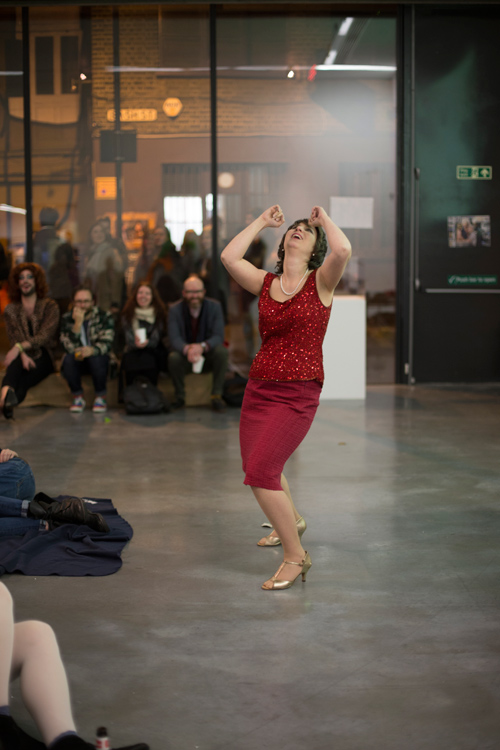I took part in yet another Live Art Development Agency DIY Workshop. This was a two-day training session run by Duckie associate artist Ursula Martinez, aimed at artists who usually supplement their artist’s income with an unrewarding part-time job. The project was designed to assist us in making a short act from which we could earn cash money. This could be a street show, a roving performance or a cabaret act.
Ursula proposed the workshop having never run one before. We were her guinea pigs as she tested out a new skill set, adding to her existing repertoire of singing, dancing and setting her tits and cunt on fire. She was very open and welcoming and began the session by talking about her many years of doing very little on the dole and one day getting up the nerve to go to an open mic at Chat’s Palace in Homerton where she sang a song. She enjoyed it so much she pursued it further and ended up getting her first paid gig at Duckie, which was in its infancy at the time. Ursula recalled the thrill of that moment, the purity of the exchange – getting up and doing what she loved for a live audience and then receiving cash in hand. The rest is history; she went on to create many more acts and eventually solo shows, many of which have toured worldwide. She described how quite simple and unoriginal acts earned her ridiculous amounts of money, these were things that she tried and tested on the cabaret scene that ended up being booked at mainstream clubs and corporate functions. I piped up and asked if she knew what made some acts more commercially successful than others. “Should I answer that?”, she replied and then went on to tell us the following:
Moneymaking acts:
– are not original
– are humorous and entertaining
– have one simple idea, you know what you’re watching from the very start
– are well-made by a skilled and confident performer
– have cool/appropriate music and therefore are short in duration, no longer than an average pop song
Ursula then showed us a number of youtube videos of acts which she felt had that special something by entertainers like Scottee, Moira Finucane and Jess Love. Something in me clicked and I felt like I finally understood what Scottee was trying to help us to achieve in the DIY workshop I took with him two years prior. What I mean is, many if not all of the qualities of a hit cabaret act are the antithesis of the characteristics of pieces from the genre of performance art (at least in its most conventional, perhaps historical form). In performance art the durational is valued, as is depth, ambiguity, non-theatricality and complexity. I see now that Scottee wanted to turn us all into cabaret performers, when at the time I thought he wanted us to explore the overlaps, contrasts and complexities of the relationship between the two differing genres. I digress.
The rest of Ursula’s workshop was spent sharing information about ideas we wanted to pursue, what we hoped to produce as a result of the workshop etc. Even Ursula presented an in-progress piece. Each person got a lot of attention and feedback from the group almost to the point where it felt like we were making art by consensus. This was great but also made me feel uneasy; as an artist I often claim to question the concept of the lone (male) genius, but here faced with the collaborative process I felt like a limp noodle, robbed of my sense of self-importance. Nevertheless, I really appreciated the fact that when someone had an idea for a piece that had been done, we watched it and let it inform the work, forging ahead instead of stopping in our tracks.
I came wanting to come up with a stage piece for an event I was invited to participate in called The Art Party Conference advocating art to government. Thanks to fellow participant Karl Taylor’s suggestion that I look up Culture Secretary Maria Miller’s recent speech on ‘Art in the Age of Austerity’, we all came up with the idea that I should lip-synch the speech and break into a dance routine to the song “There’s No Business Like Show Business”. In the speech, Ms Miller argues that the arts and culture are not exempt from funding cuts; artists and arts organisations must realise that government funding “is a two way street”. For most of the workshop and for at least a month following I was pretty unconvinced about the idea. Would it work? Was it mine and could it be, since it really was Karl’s and Ursula’s and Paula Varjack’s idea really? At the same time, it’s probably unnecessary to point out the irony that my money-making cabaret act makes fun of the idea that artists should be made to pay their part toward “reducing the deficit”.
Eventually, in my own time, I finally got into it. I decided to dump the lip-synching in favour of working on my British accent, added a hilarious powerpoint and mixed “No Business” with a mash-up of songs about money including the Jay-Z track “Money, Cash, Hoes”. My choreographer Katherine Shirley came up with the awesome moves that I diligently practiced to perfection. It had been at least three years since I’d worked with Katherine, which is far too long. When I first started performing I used to have dance in every piece I made and now I intend to continue as I began. In the end, the act was far better received as a performance than the other thing (The O Show) I presented at The Art Party, which was entirely my idea. I’m also proud to report my Maria Miller act has had second and third airings at I’m with You: Daytime Drama and the DIY picnic.

photo: Christa Holka